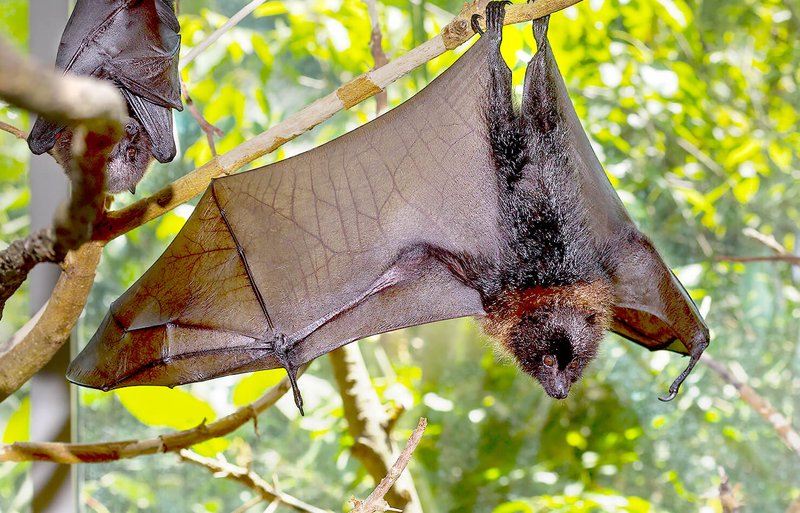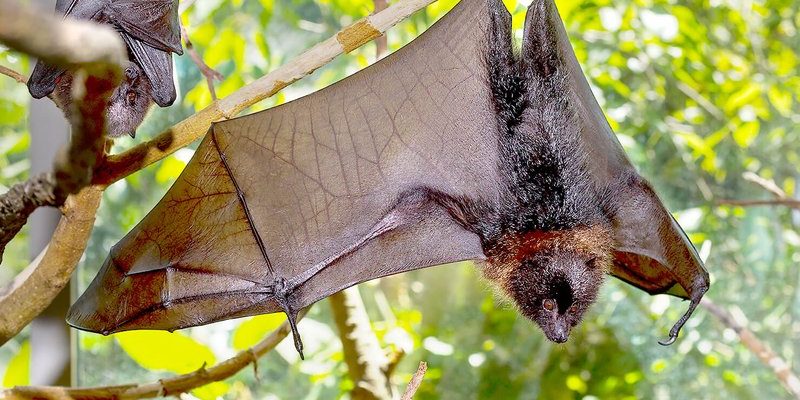
The Rodrigues Flying Fox, also known as the Rodrigues Fruit Bat, is a fascinating creature that plays a crucial role in its ecosystem. Imagine a tiny superhero, soaring through the night skies of Rodrigues Island, munching on fruits and spreading seeds. This bat is not just another mammal; it’s an essential player in maintaining the health of its habitat. Did you know that by simply feeding on fruits, these flying foxes help in the regeneration of trees? It’s like nature’s way of ensuring that forests can grow strong and lush.
These remarkable bats are unique to Rodrigues Island, which is part of the Mascarenhas archipelago in the Indian Ocean. Once facing serious threats from habitat loss and hunting, conservation efforts have helped stabilize their population. You might be wondering why they matter so much. Well, they’re not only adorable with their large eyes and furry bodies, but they also help in pollination and the dispersal of plant seeds, which can drastically impact the ecosystem.
Physical Characteristics
The Rodrigues Flying Fox is a medium-sized bat, with a wingspan that can range from 3.3 to 3.9 feet. When you see them soaring, their large wings look almost like a black cape fluttering in the night sky. Their bodies are covered in thick fur that varies in color from a golden-brown to dark chocolate. This fur helps keep them warm during the cooler nights and provides a bit of camouflage against tree bark.
One of their most distinctive features is their large, expressive eyes, which are adapted for night vision. Imagine walking into a dark room and suddenly your eyes adjust to the surroundings; that’s how these bats navigate the night. Their eyesight is excellent, allowing them to spot ripe fruits from afar. Furthermore, their keen sense of smell plays a significant role in locating food, making them quite the gourmet fruit connoisseurs!
Habitat and Distribution
The Rodrigues Flying Fox is endemic to Rodrigues Island, meaning it’s not found anywhere else in the world. This small island, measuring about 108 square kilometers, is home to lush tropical forests and a diverse range of plant life. These bats prefer the dense canopy of trees, where they can easily find their favorite fruits and be safe from predators. Picture a cozy tree full of ripe guavas or figs — that’s a buffet for these flying foxes!
Unfortunately, this habitat has been shrinking due to agriculture and urban development. As the forests disappear, so too do the food sources that the Rodrigues Flying Fox relies on. Thankfully, conservation programs have started to replant native trees and create protected areas to help sustain their population. It’s a heartwarming reminder that with a little effort, nature can bounce back.
Diet and Feeding Habits
You might have guessed that the Rodrigues Flying Fox has a pretty tasty diet. These bats primarily feast on fruits like guavas, figs, and bananas. Their large teeth are perfect for biting into soft fruits, allowing them to enjoy the sweetest parts. As they munch on their meals, they inadvertently help the environment by dispersing seeds. Think of them as nature’s delivery service, helping fruits grow in new places!
They have a unique feeding style, often hanging upside down from branches while they eat. This position helps them access the fruit more easily and also keeps them safe from ground predators. Imagine enjoying a snack while comfortably swinging from a tree — sounds fun, right? This feeding behavior is not only entertaining but also crucial for the regeneration of their favorite fruits.
Behavior and Social Structure
Rodrigues Flying Foxes are incredibly social animals, often found roosting in large groups during the day. This communal lifestyle helps them stay safe from predators and allows them to maintain social bonds. These bats communicate using various vocalizations, high-pitched sounds that might remind you of a lively conversation among friends. It’s part of their charm and social structure.
During the night, they fly out in search of food, sometimes traveling long distances to find the best fruits. Watching a flock of these bats take off at dusk is a breathtaking sight, as they fill the sky with their graceful wings. Their social habits and playful interactions bring a lively energy to the forests of Rodrigues, showcasing the beauty of teamwork in nature.
Conservation Status
The conservation status of the Rodrigues Flying Fox has improved over the years, but they are still classified as vulnerable. Their population was severely impacted in the past due to hunting and habitat loss. Fortunately, conservationists rallied to protect them and their home. This included creating protected areas and implementing breeding programs to ensure their survival.
It’s heartening to see how awareness and conservation efforts have led to a gradual increase in their numbers. Local communities are also getting involved, recognizing the importance of these bats for their ecosystem. By working together, we can help ensure that the Rodrigues Flying Fox continues to thrive, allowing future generations to experience the magic they bring to the island.
Fun Facts
- The Rodrigues Flying Fox can live up to 15 years in the wild.
- They are nocturnal, meaning they’re most active at night.
- These bats can weigh between 300 to 500 grams, making them relatively light for their size.
- Each bat can consume up to 40 grams of fruit in one night!
Impact on the Ecosystem
The role of the Rodrigues Flying Fox in the ecosystem is truly vital. As they feed on fruits, they help in seed dispersal, which can lead to the growth of new plants and trees. This process is essential for maintaining biodiversity in their habitat. Imagine planting a small seed — with a little time and care, it can grow into a towering tree that provides shelter for other species.
Moreover, their activities contribute to pollination. As they travel from fruit to fruit, they may inadvertently transfer pollen, which is beneficial for flowering plants. This interconnectedness in nature reminds us of how every species, no matter how small, plays a significant role in the larger picture.
FAQ
What does the Rodrigues Flying Fox look like?
The Rodrigues Flying Fox has a distinctive appearance, featuring a large wingspan of up to 3.9 feet. Its fur varies in color, from golden-brown to dark chocolate, and its big eyes are adapted for nocturnal vision. This unique look makes them one of the most recognizable bats in the world!
Are Rodrigues Flying Foxes dangerous to humans?
No, Rodrigues Flying Foxes pose no threat to humans. They primarily feed on fruits and do not have aggressive tendencies. While they may be large, they are harmless and shy creatures that prefer to avoid human interaction.
What do Rodrigues Flying Foxes eat?
These bats enjoy a diet rich in fruits, particularly guavas, figs, and bananas. They play a vital role in their ecosystem by aiding in seed dispersal while feeding on these fruits. Essentially, they contribute to the growth of trees in their habitat!
How long can Rodrigues Flying Foxes live?
In the wild, Rodrigues Flying Foxes can live for up to 15 years. Their lifespan can be influenced by factors such as food availability, predation, and habitat quality, making conservation efforts critical for their longevity.
Are Rodrigues Flying Foxes solitary or social animals?
Rodrigues Flying Foxes are social creatures. They often roost in large groups during the day, which helps them stay safe from predators and maintain social bonds. Their playful interactions reflect a strong sense of community among these bats.
What is being done to conserve Rodrigues Flying Foxes?
Conservation efforts have led to the establishment of protected areas and breeding programs to save the Rodrigues Flying Fox from extinction. Local communities are also becoming more involved, recognizing the importance of these bats to their ecosystem and working to protect their habitat.
Where can I see Rodrigues Flying Foxes?
Rodrigues Flying Foxes are endemic to Rodrigues Island. If you plan to visit, head into the forests during the early evening when they begin their nightly foraging. Observing them in their natural habitat is a truly memorable experience!
What threats do Rodrigues Flying Foxes face?
The primary threats to the Rodrigues Flying Fox include habitat loss due to agricultural expansion, hunting, and climate change. Conservation efforts are essential to mitigate these threats and safeguard the future of this unique species.
Do Rodrigues Flying Foxes have any predators?
While they have few natural predators, young flying foxes can fall prey to larger birds of prey. However, their main threats come from human activities, such as hunting and habitat destruction, rather than natural predation.
How do Rodrigues Flying Foxes communicate?
Rodrigues Flying Foxes communicate using a variety of vocalizations, including high-pitched sounds. These calls play an important role in maintaining social bonds within their roosting groups, making their interactions lively and engaging.
Why are Rodrigues Flying Foxes important for the environment?
These bats are crucial for their ecosystem because they aid in seed dispersal and pollination. By feeding on fruits, they help ensure the growth of new plants, contributing to the overall health and biodiversity of their environment.
Can Rodrigues Flying Foxes fly long distances?
Yes, Rodrigues Flying Foxes are known to travel significant distances while foraging for food. They can fly several kilometers in search of ripe fruits, showcasing their impressive flying abilities and navigation skills.

